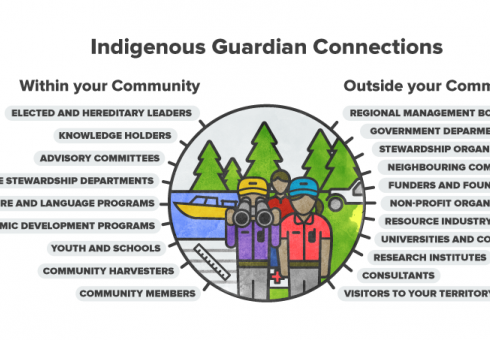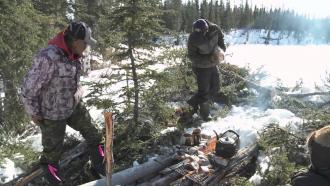Program reporting - Annual reports, program briefings, presentations to Council, Management Boards, etc. Consider scheduling standing meetings (i.e. monthly, annually) to connect across departments, with Council, or with key decision-makers to keep them informed of your program activities. The Northeast Superior Regional Chiefs' Forum share their intro to their Guardian Program developed to let community members know what they plan for the season.
Program updates - Regular updates in newsletters, blogs, radio ads, social media (i.e. Facebook, Twitter), etc. These can be short and sweet. Often, the more regular the better. The Northeast Superior Regional Chiefs' Forum share their Guardian Program End of Season Update for ideas.
Printed resources - Program brochures, information sheets, maps, posters, etc. Having print information you can leave behind gives people time to absorb and think about what you’re sharing. Below you will find links to several examples of newsletters and brochures developed for guardian program outreach.
Workshops and small group sessions - Working sessions focused on specific issues, priority setting, program planning, etc. Small group or focused sessions can encourage higher participation as many people feel more comfortable speaking. See the article 'A Model for Aboriginal Facilitation' for tools on increasing participation at meetings.
Community meetings - Meetings, open houses, feasts, etc. Use events to share program updates, data and findings, solicit ideas and feedback, recognize guardians and community members, celebrate success, etc. To increase event attendance consider supporting people by providing transportation, child care, food, translation services, etc.
Open feedback channels - Provide people with a phone contact line, email address, online surveys or feedback forms, etc. Invite feedback in many ways so people can reach out in the way they feel most comfortable. Remember to always follow up!
Website - You may or may not want or need a dedicated website for your program, but an online “home base” may help people in the community and beyond find your program fast. At minimum, consider building a simple profile for your program through an established website or existing page. This will help ensure a quick and easy search leads people to your program and important contact information.
Social and other media - Using social media such as Facebook and Twitter can be a great way to keep people informed about your program. It can also act as a feedback channel. Be sure to set social media policies to ensure communication remains respectful. Call-in radio shows are another great way to have a public dialogue with community members. See how the Gitanyow use Facebook to manage wildlife populations in the story 'Using Facebook to Manage Moose Populations on Gitanyow Territory'.
Visual stories - Produce and share program video, slide shows, photos, maps, stories, field experiences, etc. People tend to engage more when the can see, hear, touch or point to what you are talking about. Maps often get people interested! The Northern Australia Indigenous Land and Sea Managers Alliance using a unique method for creating visual stories called 'Story Reporting'.
Community outreach - Have guardians participate in or attend other community gatherings, meetings, social groups, elders groups, youth camps, celebrations, etc. Sit, talk, share and listen.
Patrols and on-the-land experiences - Invite community members out with your guardians to share and learn (remembering to address any liability/safety/risk concerns). Share information about when and where your guardians’ are headed and what they are doing. Have guardians support or participate in community and children’s camps.
Contests - Engage community members through logo contests, photo contests, writing contests, trivia, etc.
Youth and children - Schedule your guardians to give class presentations, attend career days, provide mentoring, host internships, guide field-trips (remembering to address any liability/safety/risk concerns), etc. Look for opportunities to include and inspire young people. For more ideas go to the 'Involve Youth' chapter of the toolkit.
Elders - Meet with Elders’ groups, host tea & bannock sessions, support food harvesting for Elders, bring in Elder advisors, etc. Think through different kinds of compensation approaches to honour the contributions that Elders bring (i.e. recognition, gifts, honoraria, etc.).
Governance - Build strong community representation into your program governance structure (i.e. advisory board, committees, etc.) Work with other community committees, departments, entities etc. to ensure the guardian program is well-aligned with other community initiatives. The section 'How will your Indigenous Guardian program be governed?' from the chapter 'Set up a Governance Structure' provides some approaches that have been taken by communities in other parts of Canada.







